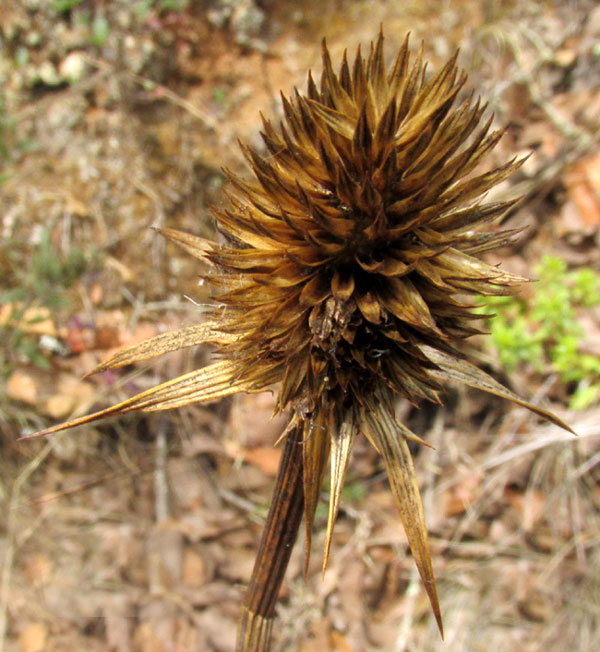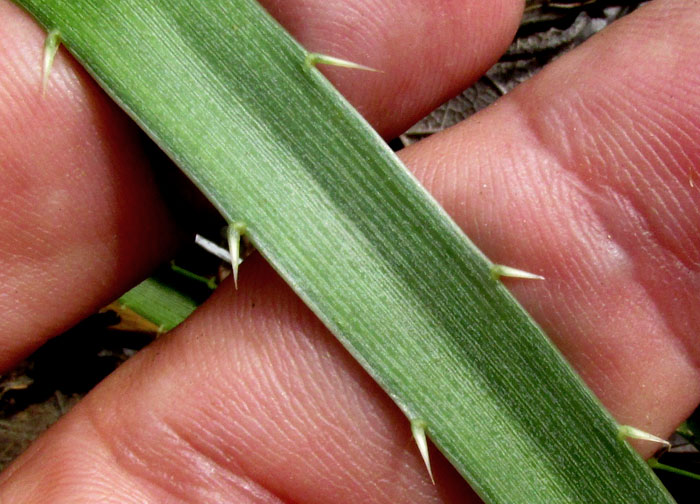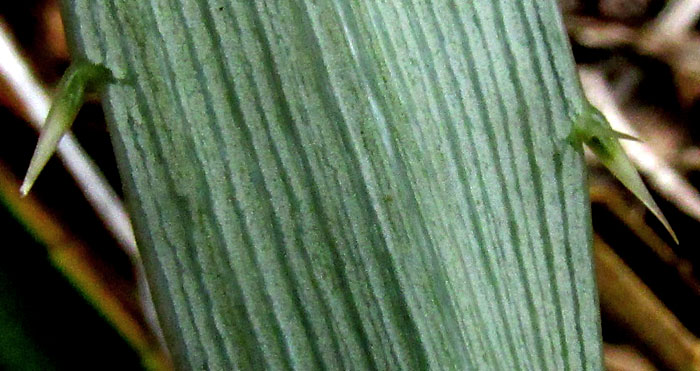Excerpts from Jim Conrad's
Naturalist Newsletter
entry from field notes dated July 2, 2022, taken on the eastern lower slope of Cerro de la Cruz, at an elevation of ~2700m (~8850 ft), just south of the community of El Pinar, Amealco de Bonfil, Querétaro, MÉXICO, (~N20.17°, ~W100.17°)
A LOWER ELEVATION ERYNGO
 On the lower eastern slope of Cerro de la Cruz, where the mountain's oak forest gives way to a rocky slope mostly covered with clumpgrasses and scrub too small for the local firewood gatherers to bother with, I was surprised to find the dried-up remains of the wildflower shown at the right. No flowers or fruits remained, just last year's stiff, prickly, egg-shaped head of flower bracteoles subtended by a flaring collar of larger bracts, on a scratchy stem with a rosette of slender, dead leaves at the base.
On the lower eastern slope of Cerro de la Cruz, where the mountain's oak forest gives way to a rocky slope mostly covered with clumpgrasses and scrub too small for the local firewood gatherers to bother with, I was surprised to find the dried-up remains of the wildflower shown at the right. No flowers or fruits remained, just last year's stiff, prickly, egg-shaped head of flower bracteoles subtended by a flaring collar of larger bracts, on a scratchy stem with a rosette of slender, dead leaves at the base.
Usually the post-flowering remains of a stiff flowering head bristling with sharp points rising above a starburst of spiny-margined bracts, with all other parts being stiff and spiny, too, means teasels or eryngos. But teasel heads have bracteoles tipped with much longer, slenderer spines and they're more numerous in the head, and closer packed together. This is an eryngo. Here's a closer look at the eryngo's head:

Eryngos are members of the Parsley Family, the Apiaceae, and the genus Eryngium. The genus embraces maybe 250 species or so, which occur worldwide. My surprise in seeing this plant was based on my customarily seeing eryngos only at elevations higher than our current ~2700m (~8850 ft). I read that some species occur in coastal areas and low-elevation grasslands, but so far my experiences with them have all been atop high mountains where trees give way to grasslands and rocky barrens.
The eryngo general preference for mountaintops may explain why the taxonomy of the genus Eryngium is so poorly understood. Each mountaintop or range of mountains constitutes an island population that in varying degrees is genetically isolated from other mountaintop populations. Darwin saw in the Galapagos that island populations tend to evolve to their island's particular environment, often to the point of becoming new species. In such disperse populations the instance of in-between species is high, and confusing, and species in the genus may use special tricks to compensate for isolation, such as more easily hybridizing, or indulging in polyploidy.
Whatever the case, I figured that identifying this plant might be a challenge, so available features were looked at closely. Fortunately, nearby there was a young eryngo not yet producing a flowering head:

The young plant's leaves bore widely spaced, slender and very sharp spines along their margins:

A closer look at the blade's undersurface showed that it was slightly paler than the top, plus sometimes the spines were "compound," with more than one point arising from their bases:

Using keys in the excellent Flora fanerogámica del Valle de México, treating vascular plants of the Valley of Mexico, which includes 12 eryngo species, we're led to ERYNGIUM MONOCEPHALUM. That species is described as endemic to parts of Veracruz and Hidalgo states south to Puebla, in pine, oak, alder and fir forests and clearings around them, at elevations of 2900-3300m (9500-10,850 ft). That range of elevations is a bit higher than our location. However, internet pictures of dried herbarium species bearing that name match our plant, so I'm sticking to that name.
Still, in the similarly authoritative Flora del Valle de Tehuacán-Cuicatlán, I key out our plant to Eryngium involucratum, described as occurring at elevations of 2400-2800m, which covers us. Online herbarium species bearing that name also look like our plants. However, the authoritative World Flora Online at this time considers Eryngium involucratum a synonym of Eryngium monocephalum, which I'm using. This, despite the author in the Flora del Valle de Tehuacán-Cuicatlán treatment assuring us that the two species are distinct, and giving good-sounding reasons why.
I stick with Eryngium monocephalum, however, because at this writing the two main go-to places to see if a binomial is currently accepted, World Flora Online, and Kew's Plants of the World Online, agree that the name Eryngium involucratum is just a synonym of Eryngium monocephalum. People like me are supposed to use such up-to-date authorities.
So this is an example of the furious confusion in the world of taxonomy these days, especially with certain groups such as the genus Eryngium.
Whatever the case, our plant was a pleasure to find. Species in the Parsley Family often contain powerful compounds that may taste good (anise, dill, coriander, caraway, cumin), kill you (Poison Hemlock), or cure you (endless traditional uses).
With regard just to eryngo species, Sinem Aslan Erdem and others in a 2015 study entitled "Blessings in disguise: a review of phytochemical composition and antimicrobial activity of plants belonging to the genus Eryngium," tells us that throughout the world eryngo species are used for the treatment of "... hypertension, gastrointestinal problems, asthma, burns, fevers, diarrhea, malaria, etc." Furthermore, eryngos are a rich source of flavonoids, tannins, saponins, and triterpenoids, while one of the most important of its compounds is eryngial, an essential oil showing a significant antibacterial effect.
For my part, this plant gives me a good feeling by evoking memories of cold, windy, high-elevation camping beneath painfully dark-blue skies with ragged, swirling white cloud-wisps, where a gorgeous diversity of eryngos shook in the wind like guffawing gnomes.